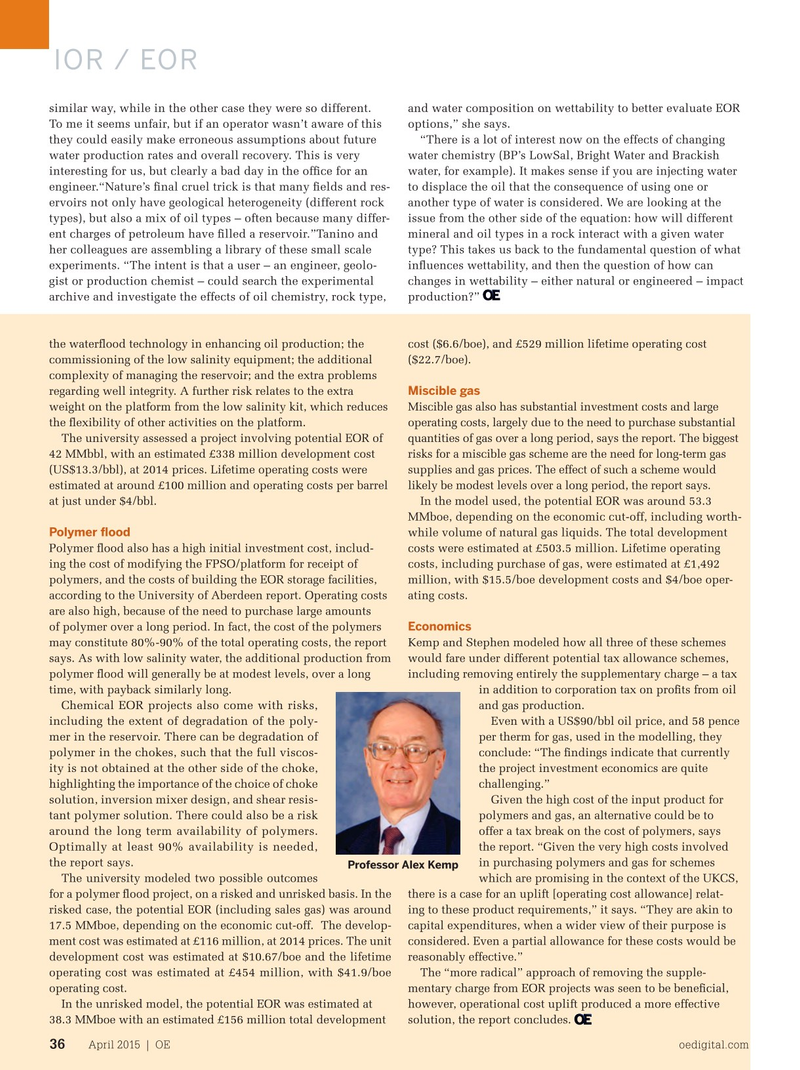
Page 34: of Offshore Engineer Magazine (Apr/May 2015)
Read this page in Pdf, Flash or Html5 edition of Apr/May 2015 Offshore Engineer Magazine
IOR / EOR similar way, while in the other case they were so different. and water composition on wettability to better evaluate EOR
To me it seems unfair, but if an operator wasn’t aware of this options,” she says. “There is a lot of interest now on the effects of changing they could easily make erroneous assumptions about future water chemistry (BP’s LowSal, Bright Water and Brackish water production rates and overall recovery. This is very water, for example). It makes sense if you are injecting water interesting for us, but clearly a bad day in the offce for an to displace the oil that the consequence of using one or engineer.“Nature’s fnal cruel trick is that many felds and res- another type of water is considered. We are looking at the ervoirs not only have geological heterogeneity (different rock issue from the other side of the equation: how will different types), but also a mix of oil types – often because many differ- mineral and oil types in a rock interact with a given water ent charges of petroleum have flled a reservoir.”Tanino and type? This takes us back to the fundamental question of what her colleagues are assembling a library of these small scale experiments. “The intent is that a user – an engineer, geolo- infuences wettability, and then the question of how can gist or production chemist – could search the experimental changes in wettability – either natural or engineered – impact archive and investigate the effects of oil chemistry, rock type, production?” the waterfood technology in enhancing oil production; the cost ($6.6/boe), and £529 million lifetime operating cost commissioning of the low salinity equipment; the additional ($22.7/boe). complexity of managing the reservoir; and the extra problems
Miscible gas regarding well integrity. A further risk relates to the extra weight on the platform from the low salinity kit, which reduces Miscible gas also has substantial investment costs and large the fexibility of other activities on the platform. operating costs, largely due to the need to purchase substantial
The university assessed a project involving potential EOR of quantities of gas over a long period, says the report. The biggest 42 MMbbl, with an estimated £338 million development cost risks for a miscible gas scheme are the need for long-term gas (US$13.3/bbl), at 2014 prices. Lifetime operating costs were supplies and gas prices. The effect of such a scheme would estimated at around £100 million and operating costs per barrel likely be modest levels over a long period, the report says. at just under $4/bbl. In the model used, the potential EOR was around 53.3
MMboe, depending on the economic cut-off, including worth-
Polymer food while volume of natural gas liquids. The total development
Polymer food also has a high initial investment cost, includ- costs were estimated at £503.5 million. Lifetime operating ing the cost of modifying the FPSO/platform for receipt of costs, including purchase of gas, were estimated at £1,492 polymers, and the costs of building the EOR storage facilities, million, with $15.5/boe development costs and $4/boe oper- according to the University of Aberdeen report. Operating costs ating costs. are also high, because of the need to purchase large amounts
Economics of polymer over a long period. In fact, the cost of the polymers may constitute 80%-90% of the total operating costs, the report Kemp and Stephen modeled how all three of these schemes says. As with low salinity water, the additional production from would fare under different potential tax allowance schemes, polymer food will generally be at modest levels, over a long including removing entirely the supplementary charge – a tax time, with payback similarly long. in addition to corporation tax on profts from oil
Chemical EOR projects also come with risks, and gas production. including the extent of degradation of the poly-
Even with a US$90/bbl oil price, and 58 pence mer in the reservoir. There can be degradation of per therm for gas, used in the modelling, they polymer in the chokes, such that the full viscos- conclude: “The fndings indicate that currently ity is not obtained at the other side of the choke, the project investment economics are quite highlighting the importance of the choice of choke challenging.” solution, inversion mixer design, and shear resis-
Given the high cost of the input product for tant polymer solution. There could also be a risk polymers and gas, an alternative could be to around the long term availability of polymers. offer a tax break on the cost of polymers, says
Optimally at least 90% availability is needed, the report. “Given the very high costs involved the report says. in purchasing polymers and gas for schemes Professor Alex Kemp
The university modeled two possible outcomes which are promising in the context of the UKCS, for a polymer food project, on a risked and unrisked basis. In the there is a case for an uplift [operating cost allowance] relat- risked case, the potential EOR (including sales gas) was around ing to these product requirements,” it says. “They are akin to 17.5 MMboe, depending on the economic cut-off. The develop- capital expenditures, when a wider view of their purpose is ment cost was estimated at £116 million, at 2014 prices. The unit considered. Even a partial allowance for these costs would be development cost was estimated at $10.67/boe and the lifetime reasonably effective.” operating cost was estimated at £454 million, with $41.9/boe The “more radical” approach of removing the supple- operating cost. mentary charge from EOR projects was seen to be benefcial,
In the unrisked model, the potential EOR was estimated at however, operational cost uplift produced a more effective 38.3 MMboe with an estimated £156 million total development solution, the report concludes.
April 2015 | OE oedigital.com 36 034-OE0415_Feat1_Aberdeen U.indd 36 3/23/15 2:26 PM

 33
33

 35
35